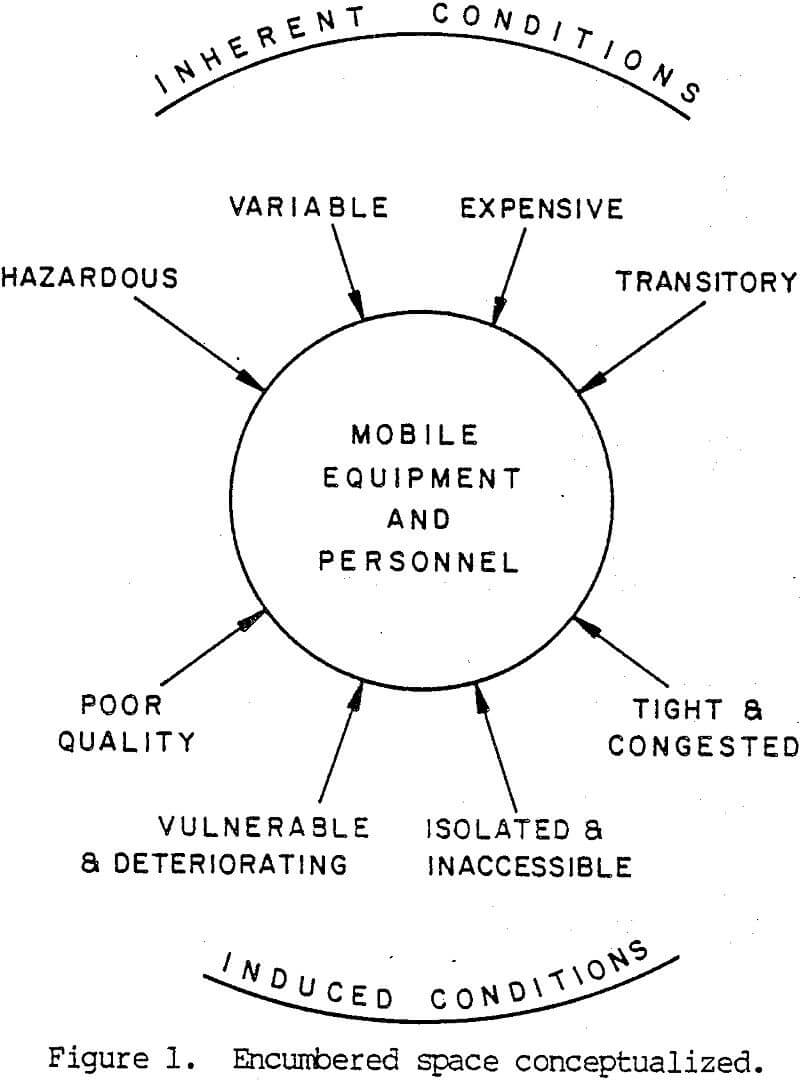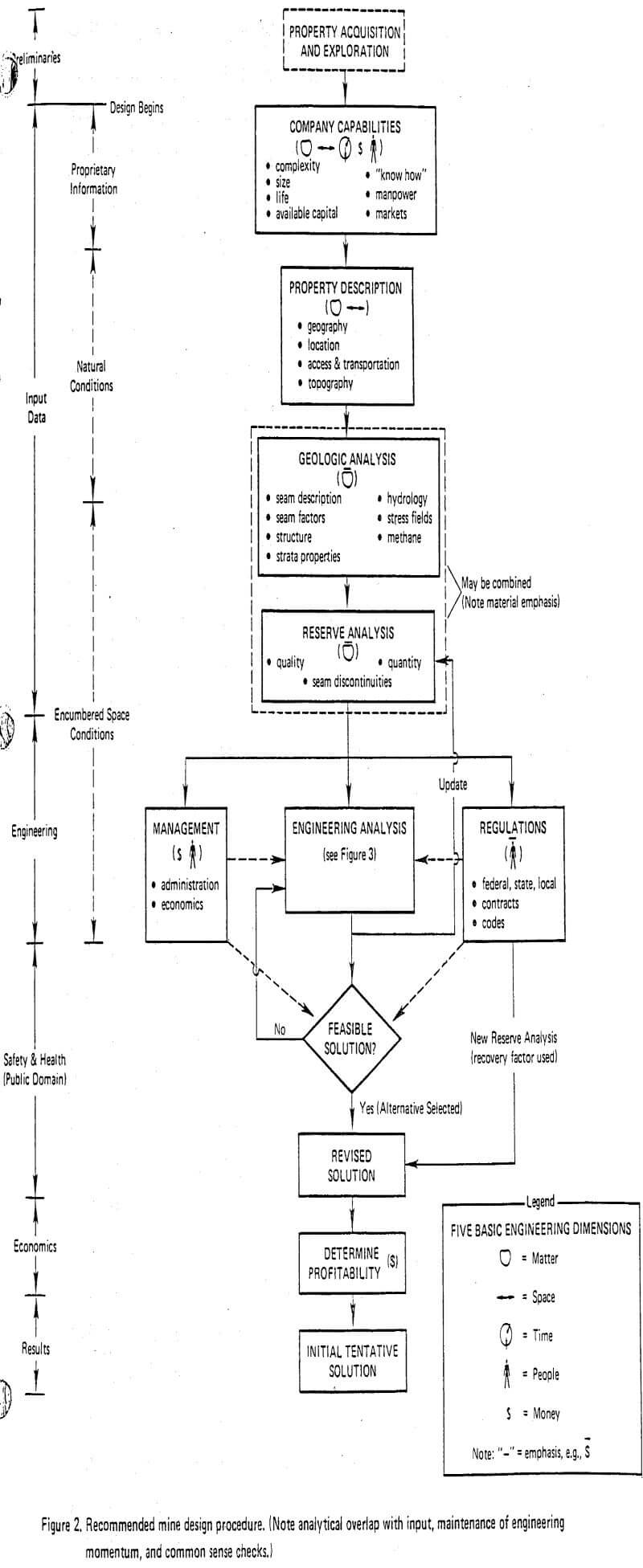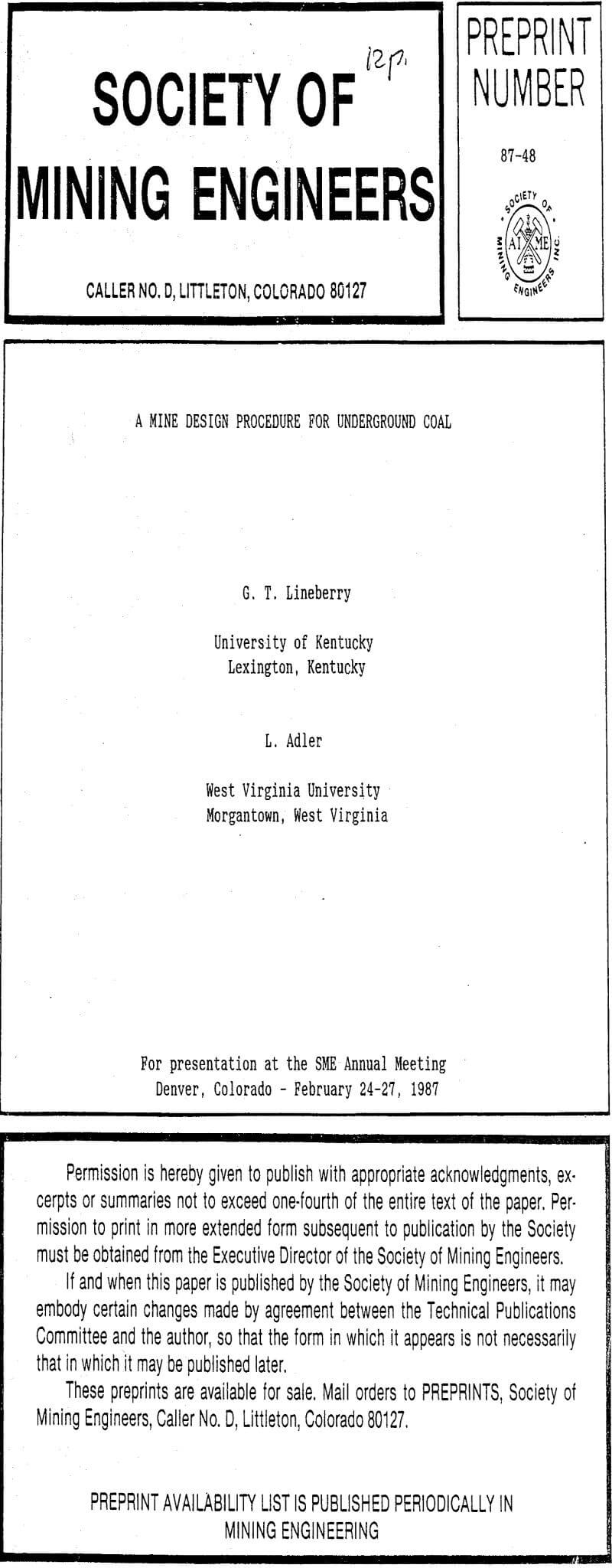Table of Contents
A systematic, comprehensive, balanced approach is presented for underground coal mine design, capable of being standardized and generalized. This approach epitomizes professionalism and must preceed the physical product. Design involves a varied senior staff and requires extensive selective input data. Engineering follows a total systems approach, operating in and for a constricting geologic setting, heavily constrained for safety, health, and environmental protection. It must also anticipate execution and operation. Engineering prominence and momentum are maintained, with sub-optimizations balanced by judgments—the “art and science” of engineering.
Input Statement
Following land acquisition and exploration (including core logging), natural conditions are evaluated. These require geographic input data for: 1) property location, 2) access and transportation facilities, and 3) topography (site selection and preparation, capital opening, surface transportation, etc.) and geologic input data for: 1) coal bed description, 2) geologic structure, 3) rock strata properties, 4) ground water existence, 5) in situ stress fields, and 6) methane emission. This evaluation results in Property Description. Geologic Analysis, and an initial Reserve Analysis.
Company capabilities can be restructured into business administration and mine administration. The broad components of business administration are money concerns and management. Money concerns are covered in: 1) finance (the company’s fiscal state, its assets and liabilities, capital formation, priorities, and current expenses); 2) marketing (sales and distribution of the maned product, including sales agreements, quality control, and ease of transportation); 3) economics (forecasting values and costs); and 4) accounting (preparing financial statements, audits, and balance sheets).
Integration Procedure
The integration of the comprehensive input statement (including natural conditions, company capabilities, and public domain) and the state-of-engineering is expressed in engineering design and control (total systems). The emphasis is on engineering, maintaining momentum throughout. As analyses are refined, Regulations and Economics are checked and cross-referenced.
The integration must start shallow, but must be orderly, inclusive, and balanced. Successive interactions will affirm or refute lower level analyses and will improve and solidify the design. It is vital that the design be modularized to facilitate interaction as iterations occur. The procedure must be open-ended and should accommodate upgraded input data (beginning with assumptions and ending with “hard” data), when discovered. It also should permit the analysis of many alternatives and should avoid rigidity. The procedure should use engineering heuristics (Koen, 1985) to cause the best change in a poorly understood design situation with the then available information. Finally, sub-optimizations should be balanced by judgment—the “art and science” of engineering. The temptation to preselect a pet alternative should be resisted.
Basic Procedure
Ground Control is vital in underground mine design. It determines roof spans, pillar size and shape, number of minable seams, and roof support requirements, and is essential to the control of floor heave, closure, bursts, roof failure, and subsidence. Because it depends upon poorly defined and highly variable geologic conditions, the ground control analysis is often unreliable. This is despite the fact that it can predominate the design.
Excavating and Bulk Handling is the primary objective of mining. This system sets the pace for all others. It determines the suitable equipment type, equipment size and horsepower, and productive capabilities (and therefore, to a large extent, layout, sequencing, and scheduling).
Layout and Sequencing include those principles used to locate the surface plant (e.g., capital opening, preparation facility, shops, offices, storage areas, water treatment facilities) and to create underground space (mains, submains, panels, blocks). At least twenty principles can be identified as competing objectives in optimizing Layout and Sequencing. This results in numerous near-optimum solutions, and, consequently, several good, balanced possibilities.
Engineering Analysis
The dominant engineering analysis in the mine design is Ground Control. Its significance rests upon preservation of life, capital, and created space, and its importance to maintaining the “winning” of ground (four of the five basic engineering dimensions). In addition, it is heavily time dependent (i.e., stand-up time, caveability, convergence).
Standard Ground Control analyses deal with: 1) material (geology, especially linears); 2) loads and pressures (depth, pillar size, etc); 3) failure and response (deformation, squeeze, rupture, burst, collapse), which are highly time-dependent; and 4) structural components, including roof (especially immediate), rib (pillar), floor, and artificial support (bolts, sets, props, cribs, trusses). Also included are sub- and superjacent formation (to surface) and subsurface water- and gas-bearing strata (coefficient of permeability, slake durability index, inflow rate, emission assessment), related to ventilation and drainage.
The primary objective of mining is to win ground, convert it to a bulk solid, and then move this material to a specific location. In accomplishing this, the Excavating and Bulk Handling system sets the pace for all other systems. A fundamental choice must be made, especially at the face, between using mobile equipment or fixed machinery. Face mobility is exemplified by room-and-pillar mining (continuous, conventional, thin-seam continuous), with a possible switch to fixed machinery, such as a belt, further back in the plant. By way of contrast, longwall mining (shearer, plow), with “continuous haulage,” is considerably more rigid.
Mining Methods
The selection of fining Method(s) and determination of mine Layout is, of course, limited to the minable reserve (longwall or room-and-pillar). It is predicated on the Ground Control and Excavating and Bulks Handling analyses and is intimately related to Economic Analysis (see later). To a great extent, selection of Mining Method(s) constrains the choice of artificial roof support, roof span design, and pillar size, as well as equipment type (both mobile face and fixed plant). After selection of the excavating equipment (face) is made, a cut sequence can be determined and standardized.
Longwalls are favored at greater depths (higher pressures and large pillars), in areas with near-zero safe spans, where caveability is good, where bumps are a hazard, and in areas of low bearing capacity. Room-and-pillar techniques are favored at lesser depths, in areas with greater safe spans, and where caveability is poor.
Longwall mining is the preferred work method in thick, uniform, homogeneous coal deposits. Room-and-pillar techniques are favored in non-homcgeneous, non-uniform deposits with varying thickness and where reject is high or where partings occur. They are also preferred when the operation is spread out over a large area in small parcels with irregular angles, where there ate oil or gas wells to be avoided, and where selectivity, flexibility, and versatility are desired.



